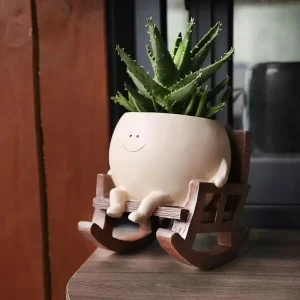Pots and Planters
author_thg2024-08-21T07:26:53+00:00Benefits of Container Gardening
Space Efficiency
Container gardening is perfect for urban settings and small spaces. Pots and planters can be placed on balconies, patios, rooftops, and even indoors.
-
Select options This product has multiple variants. The options may be chosen on the product pageQuick ViewPots and Planters
3-Tier Wrought Iron Bicycle Plant Stand
$79.08 – $129.360 out of 5There is no AI review summary. -
Select options This product has multiple variants. The options may be chosen on the product pageQuick ViewPots and Planters
Artificial Lotus Flowers – 15 Pcs Pond Decoration
$4.960 out of 5There is no AI review summary. -
New Arrivals, Pots and Planters
Cute Resin Face Planter Pots for Indoor Plants
$35.77 Buy now0 out of 5There is no AI review summary. -
Select options This product has multiple variants. The options may be chosen on the product pageQuick ViewNew Arrivals, Pots and Planters
Handmade Macrame Hanging Plant Hanger
$4.96 – $5.110 out of 5There is no AI review summary. -
Select options This product has multiple variants. The options may be chosen on the product pageQuick ViewBest Selling, Pots and Planters
Hanging Artificial Violet Flowers Basket
$112.290 out of 5There is no AI review summary. -
Select options This product has multiple variants. The options may be chosen on the product pageQuick ViewPots and Planters
Human Face Flower Pot with Drainage Hole
$35.43 – $35.460 out of 5There is no AI review summary. -
Select options This product has multiple variants. The options may be chosen on the product pageQuick ViewBest Selling, Pots and Planters
Imitation Purple Clay Succulent Pots with Trays
$8.52 – $15.030 out of 5There is no AI review summary.
Mobility
Move pots and planters as needed to optimize sunlight, protect plants from weather, and rearrange your garden layout.
Control Over Soil and Water
Tailor soil mixes for specific plants and ensure proper drainage to reduce the risk of overwatering or root rot.
Reduced Weed and Pest Issues
Containers often result in fewer weed problems and help minimize pest infestations. Elevated planters can deter certain pests, making it easier to monitor and manage issues.
Types of Pots and Planters
Traditional Pots
Available in various sizes, shapes, and materials, traditional pots typically have drainage holes and are suitable for a wide range of plants.
Hanging Planters
Ideal for adding vertical interest, hanging planters are perfect for trailing plants like petunias, ferns, and ivy.
Window Boxes
Long, narrow containers designed for windowsills or railings, suitable for flowers, herbs, and small vegetables.
Raised Planters
Elevated containers that combine the benefits of raised beds and traditional pots, making them accessible for those with physical limitations.
Self-Watering Planters
Featuring a built-in reservoir, self-watering planters provide a consistent water supply, ideal for busy gardeners.
Decorative Planters
Available in various designs, colors, and materials, decorative planters add aesthetic appeal to any garden space.
Materials for Pots and Planters
Terracotta
Classic and rustic, terracotta pots are porous, allowing air and moisture to pass through. However, they dry out quickly and may crack in freezing temperatures.
Plastic
Lightweight, durable, and available in various colors, plastic pots retain moisture well and are resistant to cracking.
Ceramic
Heavy and stable, ceramic pots often have a glazed finish. They retain moisture well but can be fragile and prone to cracking in cold weather.
Metal
Durable and modern, metal planters resist weather and pests but can heat up quickly in sunlight. Use a liner to mitigate heat.
Wood
Attractive and natural, wooden planters blend well with surroundings but can rot over time. Use rot-resistant wood and sealants to extend their life.
Fabric
Breathable and durable, fabric pots promote excellent air circulation to roots. They are lightweight and foldable but may dry out quickly.
Tips for Successful Container Gardening
Choosing the Right Plants
Select compact, dwarf, or bush varieties for smaller pots. Consider sunlight and temperature to choose plants suited to your environment.
Soil Mix
Use a high-quality potting mix for container gardening. Opt for a lightweight, well-draining mix with organic matter.
Watering
Check soil moisture regularly and water when the top inch is dry. Water thoroughly until it drains from the bottom. Consider self-watering planters for consistent moisture.
Fertilizing
Regularly fertilize container plants with a balanced, water-soluble fertilizer to replenish nutrients. Follow application instructions.
FAQs
Q: How often should I water my container plants?
A: Water when the top inch of soil feels dry. Frequency varies by plant type and weather.
Q: Can I use garden soil in my pots and planters?
A: Use a high-quality potting mix for adequate drainage.
Q: How do I prevent my pots from drying out too quickly?
A: Use mulch and consider self-watering planters. Provide shade during the hottest part of the day.
Q: What are the best plants for container gardening?
A: Compact, dwarf, or bush varieties like herbs, lettuce, tomatoes, and peppers are ideal.
Shop Now
Explore our wide range of pots and planters to find the perfect containers for your gardening needs. Whether you’re looking for traditional pots, hanging planters, or self-watering options, we have something for every gardener.















